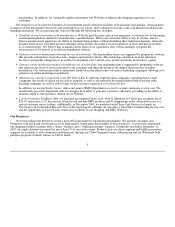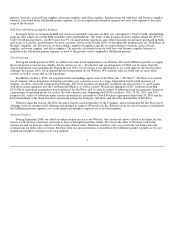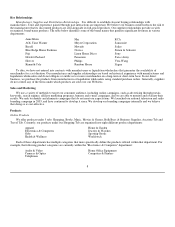Overstock.com 2005 Annual Report Download - page 18
Download and view the complete annual report
Please find page 18 of the 2005 Overstock.com annual report below. You can navigate through the pages in the report by either clicking on the pages listed below, or by using the keyword search tool below to find specific information within the annual report.
We depend upon third-party delivery services to deliver our products to our customers on a timely and consistent basis.
Deterioration in our relationship with any one of these third parties could decrease our ability to track shipments, cause
shipment delays, and increase our shipping costs and the number of damaged products.
We rely upon multiple third parties for the shipment of our products. Because we do not have a written long-term agreement with
any of these third parties, we cannot be sure that these relationships will continue on terms favorable to us, if at all. Unexpected
increases in shipping costs or delivery times, particularly during the holiday season, could harm our business, prospects, financial
condition and results of operations. If our relationships with these third parties are terminated or impaired or if these third parties are
unable to deliver products for us, whether through labor shortage, slow down or stoppage, deteriorating financial or business
condition, responses to terrorist attacks or for any other reason, we would be required to use alternative carriers for the shipment of
products to our customers. In addition, conditions such as adverse weather can prevent any carriers from performing their delivery
services, which can have an adverse effect on our customers' satisfaction with us. In any of these circumstances, we may be unable to
engage alternative carriers on a timely basis, upon terms favorable to us, or at all. Changing carriers would likely have a negative
effect on our business, prospects, operating results and financial condition. Potential adverse consequences include:
• reduced visibility of order status and package tracking;
• delays in order processing and product delivery;
• increased cost of delivery, resulting in reduced gross margins; and
• reduced shipment quality, which may result in damaged products and customer dissatisfaction.
A significant number of merchandise returns could harm our business, financial condition and results of operations.
We allow our customers to return products and, beginning July 1, 2003, we started accepting returns of products sold through our
fulfillment partners. We modify our policies relating to returns from time to time, and any policies intended to reduce the number of
product returns may result in customer dissatisfaction and fewer return customers. If merchandise returns are significant, our business,
prospects, financial condition and results of operations could be harmed.
If the products that we offer on our Websites do not reflect our customers' tastes and preferences, our sales and profit margins
would decrease.
Our success depends in part on our ability to offer products that reflect consumers' tastes and preferences. Consumers' tastes are
subject to frequent, significant and sometimes unpredictable changes. Because the products that we sell typically consist of
manufacturers' and retailers' excess inventory, we have limited control over the specific products that we are able to offer for sale. If
our merchandise fails to satisfy customers' tastes or respond to changes in customer preferences, our sales could suffer and we could
be required to mark down unsold inventory which would depress our profit margins. In addition, any failure to offer products in line
with customers' preferences could allow our competitors to gain market share. This could have an adverse effect on our business,
prospects, results of operations and financial condition.
We face risks relating to our inventory.
We directly purchase some of the merchandise that we sell on our Websites. We assume the inventory damage, theft and
obsolescence risks, as well as price erosion risks for products that we purchase directly. These risks are especially significant because
some of the merchandise we sell on our Websites are
15
























